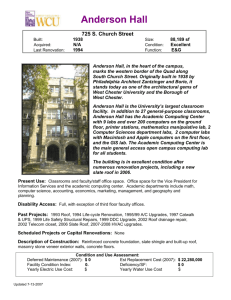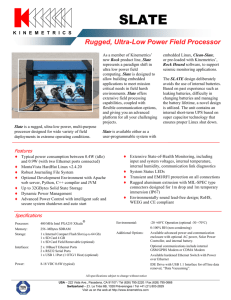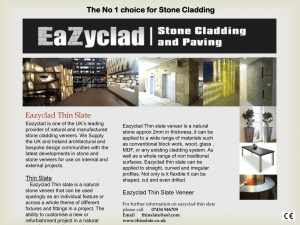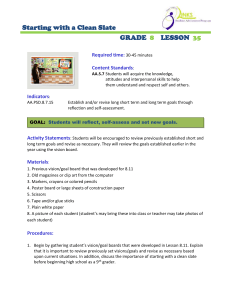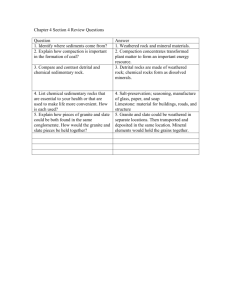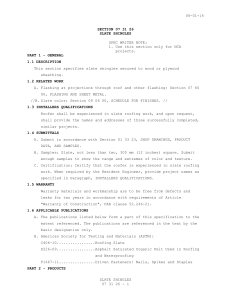************************************************************************** USACE / NAVFAC / AFCEC / NASA ...
advertisement
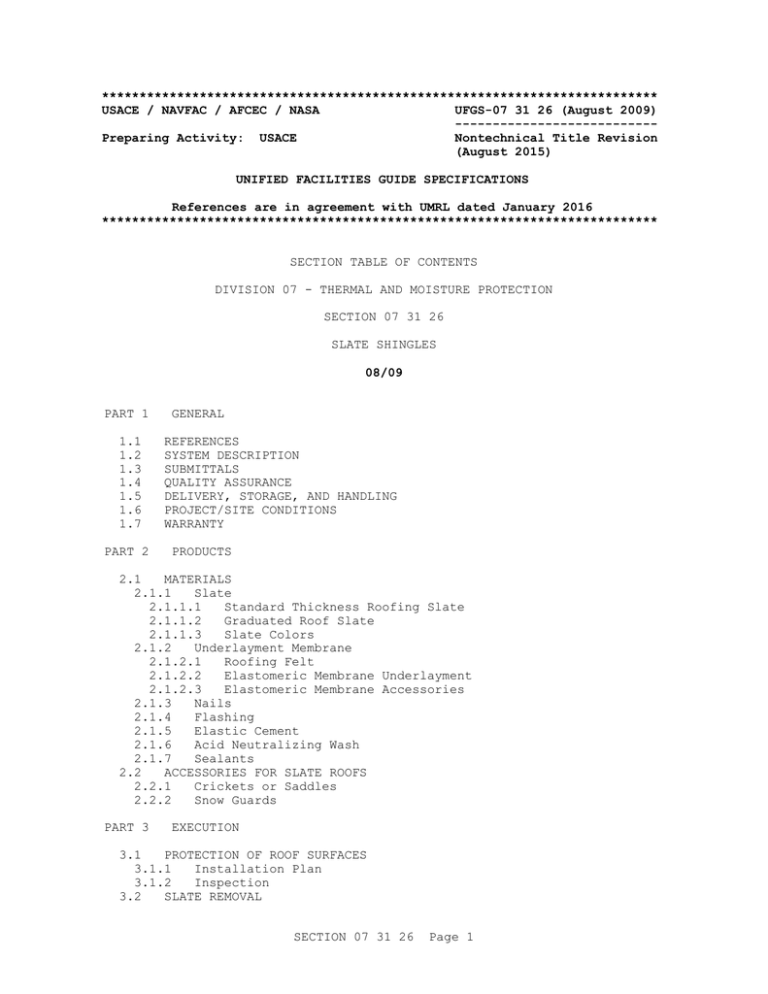
************************************************************************** USACE / NAVFAC / AFCEC / NASA UFGS-07 31 26 (August 2009) --------------------------Preparing Activity: USACE Nontechnical Title Revision (August 2015) UNIFIED FACILITIES GUIDE SPECIFICATIONS References are in agreement with UMRL dated January 2016 ************************************************************************** SECTION TABLE OF CONTENTS DIVISION 07 - THERMAL AND MOISTURE PROTECTION SECTION 07 31 26 SLATE SHINGLES 08/09 PART 1 1.1 1.2 1.3 1.4 1.5 1.6 1.7 PART 2 GENERAL REFERENCES SYSTEM DESCRIPTION SUBMITTALS QUALITY ASSURANCE DELIVERY, STORAGE, AND HANDLING PROJECT/SITE CONDITIONS WARRANTY PRODUCTS 2.1 MATERIALS 2.1.1 Slate 2.1.1.1 Standard Thickness Roofing Slate 2.1.1.2 Graduated Roof Slate 2.1.1.3 Slate Colors 2.1.2 Underlayment Membrane 2.1.2.1 Roofing Felt 2.1.2.2 Elastomeric Membrane Underlayment 2.1.2.3 Elastomeric Membrane Accessories 2.1.3 Nails 2.1.4 Flashing 2.1.5 Elastic Cement 2.1.6 Acid Neutralizing Wash 2.1.7 Sealants 2.2 ACCESSORIES FOR SLATE ROOFS 2.2.1 Crickets or Saddles 2.2.2 Snow Guards PART 3 EXECUTION 3.1 PROTECTION OF ROOF SURFACES 3.1.1 Installation Plan 3.1.2 Inspection 3.2 SLATE REMOVAL SECTION 07 31 26 Page 1 3.3 PREPARATION OF SURFACES 3.4 ROOFING FELT 3.5 ELASTOMERIC MEMBRANE UNDERLAYMENT 3.5.1 Surface Preparation 3.5.2 Primer 3.5.3 Membrane Application 3.5.4 Valley and Ridge Application 3.5.5 Vertical Membrane Flashings 3.5.6 Protection 3.6 METAL FLASHING 3.7 SLATING 3.7.1 Repair and Replacement 3.7.2 Slate Coursing 3.7.3 Nailing 3.7.4 Vertical Surfaces 3.7.5 Hips 3.7.6 Ridges 3.7.7 Valleys -- End of Section Table of Contents -- SECTION 07 31 26 Page 2 ************************************************************************** USACE / NAVFAC / AFCEC / NASA UFGS-07 31 26 (August 2009) --------------------------Preparing Activity: USACE Nontechnical Title Revision (August 2015) UNIFIED FACILITIES GUIDE SPECIFICATIONS References are in agreement with UMRL dated January 2016 ************************************************************************** SECTION 07 31 26 SLATE SHINGLES 08/09 ************************************************************************** NOTE: This guide specification covers the requirements for slate roofing on new construction and on historic buildings which require replacement, reinstallation, or repair of slate roofs. Adhere to UFC 1-300-02 Unified Facilities Guide Specifications (UFGS) Format Standard when editing this guide specification or preparing new project specification sections. Edit this guide specification for project specific requirements by adding, deleting, or revising text. For bracketed items, choose applicable items(s) or insert appropriate information. Remove information and requirements not required in respective project, whether or not brackets are present. Comments, suggestions and recommended changes for this guide specification are welcome and should be submitted as a Criteria Change Request (CCR). ************************************************************************** PART 1 1.1 GENERAL REFERENCES ************************************************************************** NOTE: This paragraph is used to list the publications cited in the text of the guide specification. The publications are referred to in the text by basic designation only and listed in this paragraph by organization, designation, date, and title. Use the Reference Wizard's Check Reference feature when you add a RID outside of the Section's Reference Article to automatically place the reference in the Reference Article. Also use the Reference Wizard's Check Reference feature to update SECTION 07 31 26 Page 3 the issue dates. References not used in the text will automatically be deleted from this section of the project specification when you choose to reconcile references in the publish print process. ************************************************************************** The publications listed below form a part of this specification to the extent referenced. The publications are referred to within the text by the basic designation only. ASTM INTERNATIONAL (ASTM) ASTM B370 (2012) Standard Specification for Copper Sheet and Strip for Building Construction ASTM C406/C406M (2015) Roofing Slate ASTM D146/D146M (2004; E 2012; R 2012) Sampling and Testing Bitumen-Saturated Felts and Woven Fabrics for Roofing and Waterproofing ASTM D226/D226M (2009) Standard Specification for Asphalt-Saturated Organic Felt Used in Roofing and Waterproofing ASTM D412 (2006a; R 2013) Standard Test Methods for Vulcanized Rubber and Thermoplastic Elastomers - Tension NATIONAL ROOFING CONTRACTORS ASSOCIATION (NRCA) NRCA 3740 (2005) The NRCA Waterproofing Manual SHEET METAL AND AIR CONDITIONING CONTRACTORS' NATIONAL ASSOCIATION (SMACNA) SMACNA 1793 1.2 (2012) Architectural Sheet Metal Manual, 7th Edition SYSTEM DESCRIPTION Salvage and reuse intact and serviceable existing slate materials whenever possible. New slate being incorporated into existing slate roofs shall match existing as closely as possible. Use slate from the same quarry or manufacturer as the original, if possible. Establish units of work, including removal of existing materials, preparation of existing surfaces and application of underlayment, nailers, and related temporary and/or permanent flashing. The progression of work shall be laid out and presented to the Contracting Officer to prevent other trades from working on or above completed roofing. Do no store materials on roof decks in such a manner as to overstress and/or damage the deck and supporting structure. Avoid placing of loads at midspans of framing so that superimposed loads are well distributed. Vertical surfaces which project through the roof surface at a right angle to the slope of the roof shall have a cricket (sometimes referred to as a saddle) built into the roof to divert water away from the back of the vertical member, as shown. SECTION 07 31 26 Page 4 1.3 SUBMITTALS ************************************************************************** NOTE: Review submittal description (SD) definitions in Section 01 33 00 SUBMITTAL PROCEDURES and edit the following list to reflect only the submittals required for the project. The Guide Specification technical editors have designated those items that require Government approval, due to their complexity or criticality, with a "G." Generally, other submittal items can be reviewed by the Contractor's Quality Control System. Only add a “G” to an item, if the submittal is sufficiently important or complex in context of the project. For submittals requiring Government approval on Army projects, a code of up to three characters within the submittal tags may be used following the "G" designation to indicate the approving authority. Codes for Army projects using the Resident Management System (RMS) are: "AE" for Architect-Engineer; "DO" for District Office (Engineering Division or other organization in the District Office); "AO" for Area Office; "RO" for Resident Office; and "PO" for Project Office. Codes following the "G" typically are not used for Navy, Air Force, and NASA projects. An "S" following a submittal item indicates that the submittal is required for the Sustainability Notebook to fulfill federally mandated sustainable requirements in accordance with Section 01 33 29 SUSTAINABILITY REPORTING. Choose the first bracketed item for Navy, Air Force and NASA projects, or choose the second bracketed item for Army projects. ************************************************************************** Government approval is required for submittals with a "G" designation; submittals not having a "G" designation are for [Contractor Quality Control approval.] [information only. When used, a designation following the "G" designation identifies the office that will review the submittal for the Government.] Submittals with an "S" are for inclusion in the Sustainability Notebook, in conformance to Section 01 33 29 SUSTAINABILITY REPORTING. Submit the following in accordance with Section 01 33 00 SUBMITTAL PROCEDURES: SD-02 Shop Drawings Drawings; G[, [_____]] SD-03 Product Data Qualifications SD-04 Samples SECTION 07 31 26 Page 5 PART 2 2.1 PRODUCTS MATERIALS ************************************************************************** NOTE: Edit these paragraphs to meet project requirements. ************************************************************************** Submit certificates of compliance attesting that the materials meet specification requirements. 2.1.1 Slate Provide slate conforming to ASTM C406/C406M. Slate shall be Grade A, (ASTM S1), hard, dense rock, punched or drilled for two nails each. Cracked slate shall not be used. Exposed corners shall be full. Broken corners on covered ends which sacrifice nailing strength or the laying of a watertight roof will not be allowed. Submit three representative shingles to show color range. 2.1.1.1 Standard Thickness Roofing Slate Slate shall be [[smooth texture] [rough texture]] [5 to 6 mm 3/16 to 1/4 inch thickness] [all [_____] thickness] [[_____] and [_____] intermingled thicknesses]. Slate shall be the following sizes: [[_____] by [_____]] [graduated lengths] [and] [random widths]. 2.1.1.2 Graduated Roof Slate Slate shall be [[smooth texture] [rough texture]] and shall vary in thickness from [_____] at eave to [_____] at ridge; the percentage of each thickness to be respectively [_____]. The thicknesses shall be intermingled in the various courses, modulating from the heavier and thicker slates in the lower courses of the roof to the thinner slates at the ridge. Slate shall be in standard random widths graduated in length from [_____] at eave to [_____] at ridge, and shall be applied with standard 75 mm 3 inch lap and exposures. 2.1.1.3 Slate Colors Slate shall be [unfading] [semi-weathering] slate. Color shall be [in accordance with Section 09 06 90 SCHEDULES FOR PAINTING AND COATING] [_____]. 2.1.2 Underlayment Membrane Furnish an underlayment membrane on all surfaces to be covered with slate. Membrane shall consist of [asphalt-saturated felt] [or] [high strength composite self-adhering membrane]. Submit a 300 by 300 mm 1 by 1 foot section. 2.1.2.1 Roofing Felt Roofing felt shall be asphalt-saturated rag felt, Type II, No. 30 asphalt felt in accordance with ASTM D226/D226M. SECTION 07 31 26 Page 7 PART 2 2.1 PRODUCTS MATERIALS ************************************************************************** NOTE: Edit these paragraphs to meet project requirements. ************************************************************************** Submit certificates of compliance attesting that the materials meet specification requirements. 2.1.1 Slate Provide slate conforming to ASTM C406/C406M. Slate shall be Grade A, (ASTM S1), hard, dense rock, punched or drilled for two nails each. Cracked slate shall not be used. Exposed corners shall be full. Broken corners on covered ends which sacrifice nailing strength or the laying of a watertight roof will not be allowed. Submit three representative shingles to show color range. 2.1.1.1 Standard Thickness Roofing Slate Slate shall be [[smooth texture] [rough texture]] [5 to 6 mm 3/16 to 1/4 inch thickness] [all [_____] thickness] [[_____] and [_____] intermingled thicknesses]. Slate shall be the following sizes: [[_____] by [_____]] [graduated lengths] [and] [random widths]. 2.1.1.2 Graduated Roof Slate Slate shall be [[smooth texture] [rough texture]] and shall vary in thickness from [_____] at eave to [_____] at ridge; the percentage of each thickness to be respectively [_____]. The thicknesses shall be intermingled in the various courses, modulating from the heavier and thicker slates in the lower courses of the roof to the thinner slates at the ridge. Slate shall be in standard random widths graduated in length from [_____] at eave to [_____] at ridge, and shall be applied with standard 75 mm 3 inch lap and exposures. 2.1.1.3 Slate Colors Slate shall be [unfading] [semi-weathering] slate. Color shall be [in accordance with Section 09 06 90 SCHEDULES FOR PAINTING AND COATING] [_____]. 2.1.2 Underlayment Membrane Furnish an underlayment membrane on all surfaces to be covered with slate. Membrane shall consist of [asphalt-saturated felt] [or] [high strength composite self-adhering membrane]. Submit a 300 by 300 mm 1 by 1 foot section. 2.1.2.1 Roofing Felt Roofing felt shall be asphalt-saturated rag felt, Type II, No. 30 asphalt felt in accordance with ASTM D226/D226M. SECTION 07 31 26 Page 7 2.1.2.2 Elastomeric Membrane Underlayment Membrane shall be a cold applied composite self-adhering membrane of not less than 0.10 mm 0.004 inch high strength polyethylene film with slip resistant embossing, coated on one side with a thick layer of adhesive-consistency rubberized asphalt, interwound with a disposable silicone coated release sheet. The tensile strength and elongation values shall be not less than 1.7 MPa 250 psi when tested in accordance with ASTM D412 and pliability shall be unaffected when tested in accordance with ASTM D146/D146M. 2.1.2.3 Elastomeric Membrane Accessories Two component urethane, mastic and primer shall be as approved by the membrane manufacturer. Flashing, expansion joint covers, temporary UV protection and corner fillets shall be as recommended by the membrane manufacturer. 2.1.3 Nails Nails shall be large-headed slater's solid copper nails of Number 10 or 11 gauge metal. Nails shall be 3d for slates 450 mm 18 inch or less in length; 4d nails shall be used for slates 500 mm 20 inch or longer, and 6d nails shall be used for slates on hips and ridges. Thicker slates require longer and heavier gauge nails. The proper size shall be determined by adding 25 mm 1 inch to twice the thickness of the slate. Nails shall be of sufficient length to adequately penetrate the roof sheathing. Nails used to retain copper flashing and slate at rake edges, hips, ridges, and eaves prone to wind damage shall be of the ring shank design. 2.1.4 Flashing Flashing shall be 0.57 kg 20 ounce, light cold-rolled temper (H00) copper conforming to ASTM B370. Flashing shall be in accordance with the requirements as specified in Section 07 57 13 FLASHING AND SHEET METAL. 2.1.5 Elastic Cement Elastic cement shall be an approved brand of waterproof elastic slater's cement colored to match as nearly as possible the general color of the slate. 2.1.6 Acid Neutralizing Wash ************************************************************************** NOTE: In areas of the country where past burning of fossil fuels has caused acid staining of slate roofs and existing portions of the roof are being reused or are to remain in place, application of an acid neutralizing wash is recommended. Edit specification to meet project requirements. ************************************************************************** Acid neutralizing wash shall be non-destructive wash formulated to neutralize the effects of acid deposits resulting from the past burning of fossil fuels (particularly coal). The wash shall not change the color, appearance, or life of the slate roof, copper flashing and accessories, underlayment, adhesives or the wall surfaces of the building. SECTION 07 31 26 Page 8 2.1.7 Sealants Sealants, where required, shall be in accordance with the slate manufacturer's recommendations. Submit 237 mL 8 ounces of each type. 2.2 2.2.1 ACCESSORIES FOR SLATE ROOFS Crickets or Saddles Provide crickets of light rafter construction covered with sheathing, underlayment, and copper sheet metal specified in Section 07 57 13 FLASHING AND SHEET METAL. If the cricket area is large and exposed to view, it shall be slated the same as other roof areas. 2.2.2 Snow Guards ************************************************************************** NOTE: Snow guards are necessary accessories for most slate roofs in sections of the country where masses of snow and ice accumulate on the roof that can slide from the roof onto lower roof surfaces and gutters. Snow guards are manufactured in various forms, and each type requires different methods of application. They may be obtained from slate distributors, quarriers of roofing slate, or manufacturers. Edit to meet project requirements. ************************************************************************** Provide nonferrous metal snow guards, as indicated. PART 3 3.1 EXECUTION PROTECTION OF ROOF SURFACES Use equipment (such as padded ridge ladders) and techniques to prevent damage to roof as a result of foot or material traffic. Contractor is responsible for controlling breakage of new or existing slate beyond what is indicated. Personnel who are working on the roof shall wear proper shoes which will not further damage slates; shoe soles shall be made of a material which will aid in preventing falls. 3.1.1 Installation Plan Submit a detailed installation plan for approval prior to beginning the work indicating the methods to be used to apply the slates to the roof and protect the installed slates from damage. The plan shall contain a narrative description and a drawing clearly depicting the layout for work access devices such as padded roof jacks for walkways, padded chicken walk placements between walkways, and other means of protecting newly installed slates and any existing slates to remain. Details shall be provided that clearly indicate how work access devices shall be installed/incorporated and the sequence of Work to include these devices. Under no circumstances shall any foot traffic be allowed on newly installed slates or existing slates to remain. The Plan shall indicate how the work access devices will keep foot traffic off the slates at all times. 3.1.2 Inspection Contractor's quality control inspections and inspections by the Government SECTION 07 31 26 Page 9 shall take place as the Work progresses to coordinate with the installation and removal of the work access devices. Notify the Contracting Officer a minimum of 48 hours in advance of requested inspections and maintain work access devices in place to provide access to uninspected areas until final acceptance by the Government. 3.2 SLATE REMOVAL Where work involves partial replacement or repair of roof, verify each slate for tightness and continued use. Perform testing with broad, flat-nosed, slater's pliers. Slates which have been identified for replacement or re-installation shall be marked with a non-destructive color mark removable by solvent, rather than water, and for approval within 30 days after Notice to Proceed. Slates fastened with non-copper fasteners shall be re-fastened with proper copper fasteners. Submit representative samples of each fastener with identifying tags. 3.3 PREPARATION OF SURFACES Roof deck surfaces shall be smooth, clean, firm, dry, and free from loose boards, large cracks, and projecting ends that might damage the roofing. Foreign particles shall be cleaned from interlocking areas to ensure proper seating and to prevent water damming. Prior to installation of slate, vents and other projections through roofs shall be properly flashed and secured in position, and projecting nails shall be driven firmly home. 3.4 ROOFING FELT Lay felt in horizontal layers with joints lapped toward eaves and at ends at least 50 mm 2 inches, and secured along laps and at ends as necessary to hold the felt in place and protect the structure until covered with the slate. Felt shall be preserved unbroken, tight and whole. Felt shall lap hips and ridges at least 300 mm 12 inches to form a double thickness and shall be lapped 50 mm 2 inches over the metal of valleys or built-in gutters. 3.5 ELASTOMERIC MEMBRANE UNDERLAYMENT ************************************************************************** NOTE: A composite self-adhering membrane will be used in areas where ice build-up (ice dams) and wind driven rains are potential problems. In such areas, underlayment installation will be detailed on the drawings. Edit these paragraphs to meet project requirements. ************************************************************************** 3.5.1 Surface Preparation Remove dust, dirt, loose nails or other protrusions. Priming is not required for wood or metal surfaces but is necessary on concrete or masonry surfaces. 3.5.2 Primer Primer shall be applied at a coverage rate of 6-9 sq. meters/L 250-350 sq. ft./gal. Primer shall be applied by spray or paint roller. Pine wood decks shall be covered with minimum 6 mm 1/4 inch plywood prior to receiving membrane coverage. SECTION 07 31 26 Page 10 3.5.3 Membrane Application Apply membrane according to manufacturer's instructions and adhere it directly to roof deck. Cut the membrane into 3 to 4.5 meter 10 to 15 foot lengths and re-roll it. The release paper shall be peeled back 300 to 600 mm 1 to 2 feet; align the membrane on the lower edge of the roof when the first 300 to 600 mm 1 to 2 feet are placed. The release paper under the membrane shall be peeled from the membrane and the membrane pressed in place. Lower edges shall be rolled firmly with a wallpaper or hand roller. For ice dam protection, apply the membrane to reach a point above the highest expected level of ice dams; refer to drawings for extent. Ends and edges shall be overlapped a minimum of 150 mm 6 inches. Membrane shall not be folded onto an exposed face of the roof edge. 3.5.4 Valley and Ridge Application Cut the membrane into 1.2 to 1.8 meter 4 to 6 foot lengths. Peel the release paper sheetand center over the valley or ridge, then drape and press in place, working from the center of the valley or ridge outward in each direction. For valleys, apply membrane shall starting at the low point and working upwards. Overlap all sheets a minimum of 150 mm 6 inches. 3.5.5 Vertical Membrane Flashings Vertical wall installations must receive primer prior to the application of membrane. Apply primer at a coverage rate of 6-9 sq. meters/L 250-350 sq. ft./gal. Membrane shall be turned up walls and dormers as indicated. Vertical membrane terminations shall be mechanically fastened and shall receive a troweling of mastic as approved by the membrane manufacturer. Membrane may be folded onto the fascia, provided it will be covered by a gutter metal edge or other material. 3.5.6 Protection Do not leave elastomeric membrane underlayment permanently exposed to sunlight. Cover membrane with exposed roofing materials as soon as possible. Patch membrane damaged due to exposure to sunlight prior to the application of final roof covering. 3.6 METAL FLASHING Metal flashing shall be as shown at intersections of vertical or projecting surfaces through the roof or against which the roof abuts, such as walls, parapets, dormers, and sides of chimneys. Flashing installation shall be in accordance with Section 07 57 13 FLASHING AND SHEET METAL. 3.7 SLATING ************************************************************************** NOTE: The best guide to traditional slating installation procedures is "Slate Roofs", published in 1925 by the National Slate Association. A reprint was issued in 1977 by the Vermont Structural Slate Co. The Steep Roofing Section of the National Roofing Contractors Association Roofing Manual contains a section on Slate Roofing which is essentially an abridged and edited version of the original 1925 publication. SECTION 07 31 26 Page 11 ************************************************************************** 3.7.1 Repair and Replacement Intermingle existing reusable slates removed from the repair area with new slates to provide a smooth visual transition between new and existing areas. Apply slating as indicated. 3.7.2 Slate Coursing The slate shall project 50 mm 2 inches at the eaves and 25 mm 1 inch at gable ends, and shall be laid in horizontal courses with 75 mm 3 inch headlap (unless otherwise indicated), and each course shall break joints with the preceding one by at least 75 mm 3 inches. Slates at the eaves or cornice line shall be doubled and canted 6 mm 1/4 inch by a wooden cant strip, using same thickness slate for under-eaves at first exposed course. Under-eave slate shall be approximately 75 mm 3 inches longer than exposure of first course. There shall be no through joints from the roof surface to the underlayment. 3.7.3 Nailing Fasten each slate with a minimum of two copper nails of sufficient length to penetrate the roof decking at least 19 mm 3/4 inch or through the decking thickness, whichever is less. Where the underside of roof decking is exposed to view, such as in overhanging eaves, the nails shall be long enough to penetrate the roof decking but not so long that they may be driven through the decking. The heads of slating nails shall just touch the slate and shall not be driven "home" or draw the slate, but left with the heads just clearing the slate so that the slate hangs on the nail. Nails in slates overlapping sheet metalwork shall not puncture the sheet metal. Exposed nails are permissible only in top courses where unavoidable, but covered with elastic cement. Hip slates and ridge slates shall be laid in elastic cement spread thickly over unexposed surface of under courses of slate, nailed securely in place and pointed with elastic cement. 3.7.4 Vertical Surfaces Fit slate neatly around pipes, ventilators, chimneys and other vertical surfaces. 3.7.5 Hips Lay hips to form a [fantail] [saddle] [mitered] [Boston] hip[ as indicated]. 3.7.6 Ridges Lay ridges to form [comb] [saddle] [strip saddle] ridges. Pass the nails of the combing slate through the joints of the slate below. Lay the combing slate with the same exposure as the next course down. Project combing slates sloping away from the direction of the prevailing storms 25 mm 1 inch above the combing slate on the opposite side of ridge. 3.7.7 Valleys Lay valleys to form [closed] [open] [round] valleys. Form open-type valleys with the main roof at cricket areas. The size of the cricket is largely determined by the roof condition. Unless noted otherwise, the SECTION 07 31 26 Page 12 slope of the cricket shall be the same as the slope of the roof. -- End of Section -- SECTION 07 31 26 Page 13
